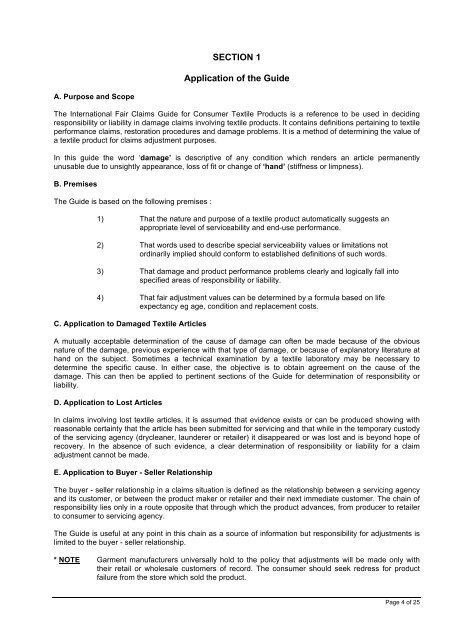international fair claims guide for consumer textiles products
international fair claims guide for consumer textiles products
international fair claims guide for consumer textiles products
Create successful ePaper yourself
Turn your PDF publications into a flip-book with our unique Google optimized e-Paper software.
A. Purpose and Scope<br />
SECTION 1<br />
Application of the Guide<br />
The International Fair Claims Guide <strong>for</strong> Consumer Textile Products is a reference to be used in deciding<br />
responsibility or liability in damage <strong>claims</strong> involving textile <strong>products</strong>. It contains definitions pertaining to textile<br />
per<strong>for</strong>mance <strong>claims</strong>, restoration procedures and damage problems. It is a method of determining the value of<br />
a textile product <strong>for</strong> <strong>claims</strong> adjustment purposes.<br />
In this <strong>guide</strong> the word ‘damage’ is descriptive of any condition which renders an article permanently<br />
unusable due to unsightly appearance, loss of fit or change of ‘hand’ (stiffness or limpness).<br />
B. Premises<br />
The Guide is based on the following premises :<br />
1) That the nature and purpose of a textile product automatically suggests an<br />
appropriate level of serviceability and end-use per<strong>for</strong>mance.<br />
2) That words used to describe special serviceability values or limitations not<br />
ordinarily implied should con<strong>for</strong>m to established definitions of such words.<br />
3) That damage and product per<strong>for</strong>mance problems clearly and logically fall into<br />
specified areas of responsibility or liability.<br />
4) That <strong>fair</strong> adjustment values can be determined by a <strong>for</strong>mula based on life<br />
expectancy eg age, condition and replacement costs.<br />
C. Application to Damaged Textile Articles<br />
A mutually acceptable determination of the cause of damage can often be made because of the obvious<br />
nature of the damage, previous experience with that type of damage, or because of explanatory literature at<br />
hand on the subject. Sometimes a technical examination by a textile laboratory may be necessary to<br />
determine the specific cause. In either case, the objective is to obtain agreement on the cause of the<br />
damage. This can then be applied to pertinent sections of the Guide <strong>for</strong> determination of responsibility or<br />
liability.<br />
D. Application to Lost Articles<br />
In <strong>claims</strong> involving lost textile articles, it is assumed that evidence exists or can be produced showing with<br />
reasonable certainty that the article has been submitted <strong>for</strong> servicing and that while in the temporary custody<br />
of the servicing agency (drycleaner, launderer or retailer) it disappeared or was lost and is beyond hope of<br />
recovery. In the absence of such evidence, a clear determination of responsibility or liability <strong>for</strong> a claim<br />
adjustment cannot be made.<br />
E. Application to Buyer - Seller Relationship<br />
The buyer - seller relationship in a <strong>claims</strong> situation is defined as the relationship between a servicing agency<br />
and its customer, or between the product maker or retailer and their next immediate customer. The chain of<br />
responsibility lies only in a route opposite that through which the product advances, from producer to retailer<br />
to <strong>consumer</strong> to servicing agency.<br />
The Guide is useful at any point in this chain as a source of in<strong>for</strong>mation but responsibility <strong>for</strong> adjustments is<br />
limited to the buyer - seller relationship.<br />
* NOTE Garment manufacturers universally hold to the policy that adjustments will be made only with<br />
their retail or wholesale customers of record. The <strong>consumer</strong> should seek redress <strong>for</strong> product<br />
failure from the store which sold the product.<br />
Page 4 of 25


